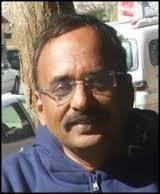 K. Krishnan is Professor in the Department of Archaeology and Ancient History at the Maharaja Sayajirao University of Baroda. During the 30 years of his career in this university, he held various posts, such as Head, Department of Archaeology and Ancient History, and currently Dean, Faculty of Arts. He was Vice President of the International Association of Asian Heritage until 2015, and has been a member of the editorial board of several national and international journals. His areas of research includes Artefact Analysis and Interpretation (using the traditional archaeological methods as well as methods from material sciences to seek answers or explanations to cultural processes such as exchange, trade, migration etc.), Ceramic Petrology (using microscopic methods to study the provenance of the raw materials, techniques of raw material processing and also the various paste preparation techniques.), Ancient Technology (through traditional and science based methods the artefacts are studied to reconstruct ancient technology both from the manufacturing processes and also their social relevance), Environmental Archaeology (understanding climate culture interaction, Hominin adaptations in central India), Harappan Studies (the regional elements in the Harappan Civilization), Origin and Development of Urbanism in South Asia and Intangible Heritage.
K. Krishnan is Professor in the Department of Archaeology and Ancient History at the Maharaja Sayajirao University of Baroda. During the 30 years of his career in this university, he held various posts, such as Head, Department of Archaeology and Ancient History, and currently Dean, Faculty of Arts. He was Vice President of the International Association of Asian Heritage until 2015, and has been a member of the editorial board of several national and international journals. His areas of research includes Artefact Analysis and Interpretation (using the traditional archaeological methods as well as methods from material sciences to seek answers or explanations to cultural processes such as exchange, trade, migration etc.), Ceramic Petrology (using microscopic methods to study the provenance of the raw materials, techniques of raw material processing and also the various paste preparation techniques.), Ancient Technology (through traditional and science based methods the artefacts are studied to reconstruct ancient technology both from the manufacturing processes and also their social relevance), Environmental Archaeology (understanding climate culture interaction, Hominin adaptations in central India), Harappan Studies (the regional elements in the Harappan Civilization), Origin and Development of Urbanism in South Asia and Intangible Heritage.
Prof. Krishnan’s doctoral research presented the chemical and petrological examination of Harappan ceramics from three regions in Gujarat and its cultural implications. He conducted his post-doctoral research at Cambridge University (St. John’s College), investigating protohistoric and Early Historic ceramics by incorporating several methods such as traditional archaeological, ethnographic and scientific. His research enabled him to develop a methodology for analyzing fine wares, understanding craft specialization, assessing the development of technology and its impact on ancient South Asian society. These studies have inspired several students from South Asia, Europe and America to conduct research on South Asian ceramics.
Prof. Krishnan has worked towards reconstructing palaeoclimates in central and western India. He has completed more than a dozen research projects dealing with ancient technology and palaeoclimatology and is currently working with five projects with national and international funding. He has participated in more than fifty excavations and directed more than ten excavations. He has guided 57 MA dissertations, 15 PhD students (with eight more ongoing), and nine post-doctoral researchers from various parts of the world. He has delivered around 200 lectures in academic institutions in India and around 70 lectures in Universities abroad (UK, USA, Oman, Jordan, Pakistan, Nepal, Sri Lanka). He has published three books (one edited) and more than 60 research articles.
Abstract of Lectures
1. Archaeology of Ceramics
Ceramics has been one of the most important artifacts in archaeology as it is useful in determining the relative chronology of an archaeological settlement. The earliest evidence of ceramics coincides with the beginning of agriculture. The appearance of ceramics may be linked to the emergence of the concept of long-time storage. As ceramics entered human history, it increased in variety and spatial distribution. It also serves as a major source of information on several intangible components of culture. To understand archaeological ceramics, it is necessary to understand contemporary traditional ceramics and its production techniques. The analysis of archaeological ceramics involves three stages: categorization, classification and characterization. This lecture will introduce the history and identity of archaeological ceramics, the significance of ethno-archaeological studies in understanding ceramics and the importance of identifying attributes to determine its typology and relative chronology.
2. Science-Based Researches in South Asian Ceramics and their Cultural Implications
The earliest studies based on scientific analytical methods were done on Indus Valley ceramics (3rd millennium BCE). They were followed by studies on Painted Grey Ware, Northern Black Polished Ware (1st millennium BCE) and subsequently many other types of ceramics. This lecture will present certain specific problem-oriented case studies and demonstrate how these data can be used for explaining the cultural processes.